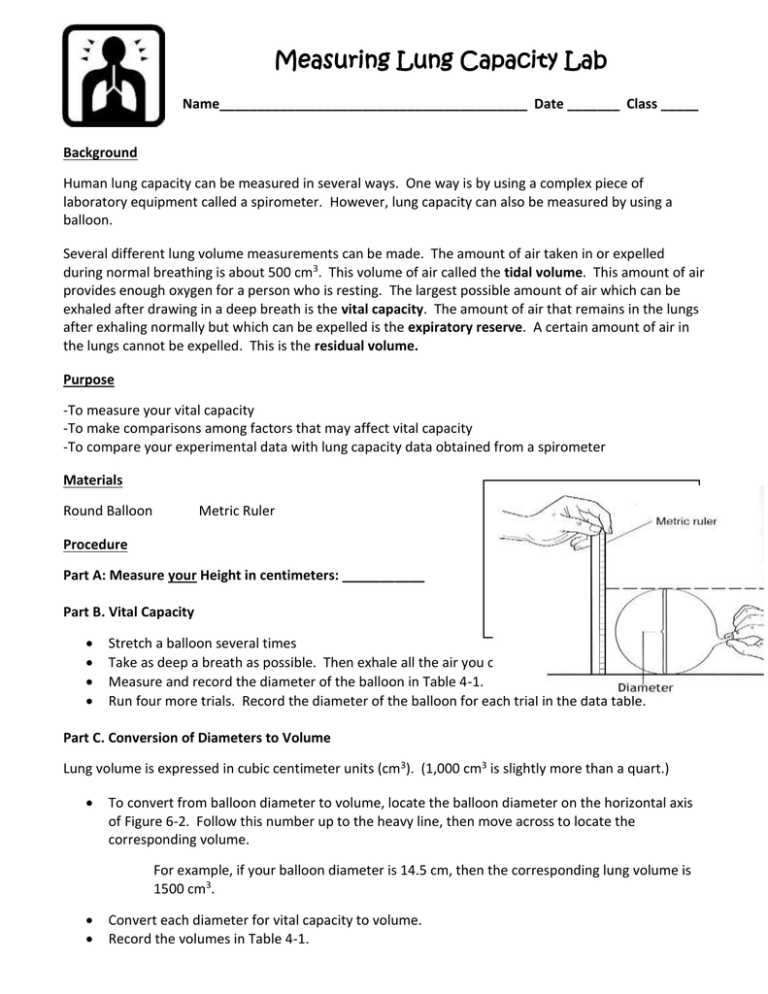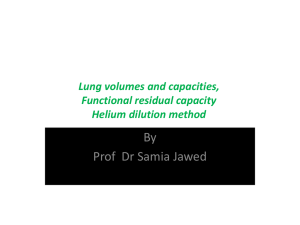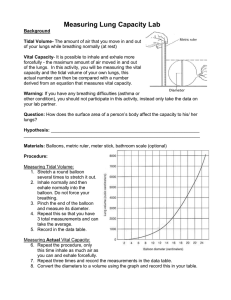Measuring Lung Capacity
advertisement

Measuring Lung Capacity Lab Name_________________________________________ Date _______ Class _____ Background Human lung capacity can be measured in several ways. One way is by using a complex piece of laboratory equipment called a spirometer. However, lung capacity can also be measured by using a balloon. Several different lung volume measurements can be made. The amount of air taken in or expelled during normal breathing is about 500 cm3. This volume of air called the tidal volume. This amount of air provides enough oxygen for a person who is resting. The largest possible amount of air which can be exhaled after drawing in a deep breath is the vital capacity. The amount of air that remains in the lungs after exhaling normally but which can be expelled is the expiratory reserve. A certain amount of air in the lungs cannot be expelled. This is the residual volume. Purpose -To measure your vital capacity -To make comparisons among factors that may affect vital capacity -To compare your experimental data with lung capacity data obtained from a spirometer Materials Round Balloon Metric Ruler Procedure Part A: Measure your Height in centimeters: ___________ Part B. Vital Capacity Stretch a balloon several times Take as deep a breath as possible. Then exhale all the air you can into the balloon. Measure and record the diameter of the balloon in Table 4-1. Run four more trials. Record the diameter of the balloon for each trial in the data table. Figure 6-1 Part C. Conversion of Diameters to Volume Lung volume is expressed in cubic centimeter units (cm3). (1,000 cm3 is slightly more than a quart.) To convert from balloon diameter to volume, locate the balloon diameter on the horizontal axis of Figure 6-2. Follow this number up to the heavy line, then move across to locate the corresponding volume. For example, if your balloon diameter is 14.5 cm, then the corresponding lung volume is 1500 cm3. Convert each diameter for vital capacity to volume. Record the volumes in Table 4-1. Calculate and record your average vital capacity Data/Results Table 4-1 Figure 6-2 Vital Capacity Balloon Diameter (cm) Lung Volume from Graph (cm3) Trail 1 2 3 4 5 Total Average Part D. Comparing Vital capacity Table 4-2: Lung Volumes of Females and Males based on Height In the table below collect the height and lung capacity of the males and females in your classroom. Graph your data. (Use 2 different colors to represent gender) Data Table: Lung Capacity: Height : Males Male (x-axis) (y-axis) Graph: Height : Lung Capacity: Female Females (x-axis) (y-axis) Height (cm) Lung Volume: Vital capacity (cm3) Table 4-3: Average Lung Volumes Male (cm3) Vital Capacity 5,000 Female (cm3) 4,000 Listed in Table 4-3 are “average” male and female lung volume measurements. The volumes were determined by using a spirometer. Discussion: 1. How does your vital capacity compare to the average lung capacity determined by using a spirometer? 2. What are three things that could be affecting your lung capacities? 3. How do males vital capacity compare with female vital capacity? 4. How might an athlete's vital capacity compare to a non-athlete? Explain your reasoning. 5. How might vital capacity be important to a musician? Examine the data table of a person who entered into a training program. This person's vital capacity was measured over a 60 day period. Data Day of Training 0 10 20 30 40 50 60 Vital Capacity 4800 4840 4890 4930 4980 5180 5260 6. What happened to the person's vital capacity over the course of the training period? 7. What probably caused the change? 8. At the respiratory surface, what process actually causes O2 to go into the blood and CO2 to go out of the blood? (Hint: Hopefully, there is a higher concentration of O2 in the air you breathe, than in the blood when you inhale.) 9. What is the benefit of having so many tiny alveoli rather than one big air sac? 10. How does the Respiratory System serve the needs of cells? 11. What is cellular respiration? How is it connected to this organ system? 12. Design an investigation to test one of the following: Do you think the air temperature will have an effect on the lung capacity of an individual? Will a person's height and/or size have an effect on their lung capacity? How does a smoker vs. nonsmoker compare for lung capacity? a) Write a step-by-step procedure for the investigation. b) Create a chart to record the type of data you would collect in your investigation. Write your procedure & chart on a separate sheet of paper and staple to the back of this lab.






